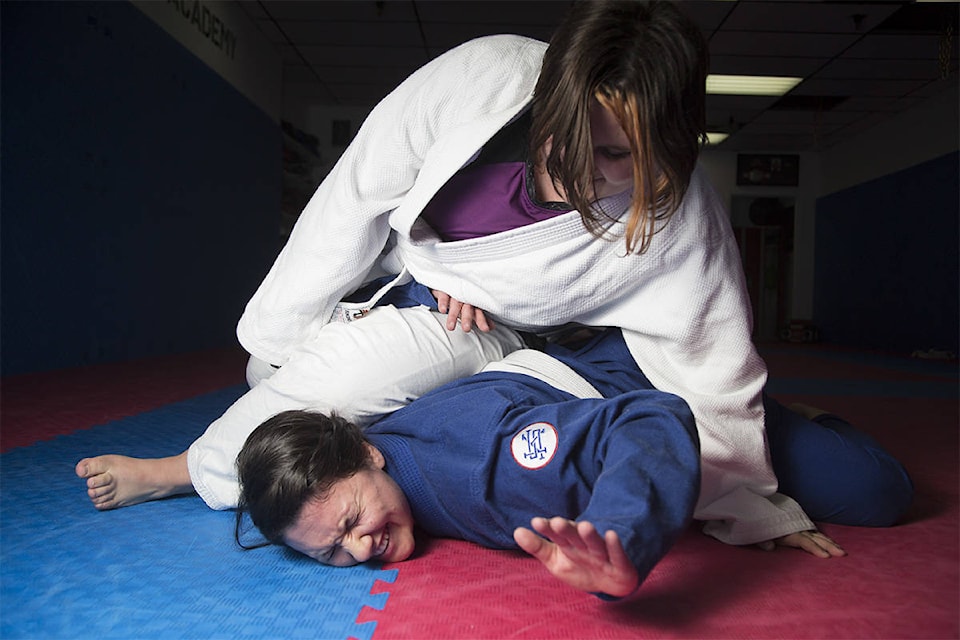Five Brazilian jiu-jitsu practitioners from Whitehorse’s Elite Martial Arts Academy are finishing preparations to compete at the upcoming 2018 Alberta Provincial Open Championship on May 12 in Calgary, Alta.
Instructor Dan Hombert said the group has been “hard prepping” for the last three months.
“We’ve been going a bit harder the last three months, but most of the students that are coming have been with us since last May,” said Hombert. “Mostly everyone except for Bobby (Woodman) and I are sort of one year into it, so it’ll be a good test to see how they do against the people from the big city.”
Woodman, a coach and co-owner alongside Hombert and Sheldon Casselman, had six years of no gi grappling experience when he started training in a gi — a traditional martial arts uniform — once the gym opened.
The tournament itself is single-elimination for adults and double-elimination for youth.
Participants are put into divisions based on belt and weight, and matches are won either via points or submission.
“You can be losing on points — let’s say in a match you get taken down, they’re on top, they’re passing your guard — but if you get them in a submission, then you win,” said Hombert. “Even if you were losing 20-0.”
Belts take approximately two years to earn with three days of training per week, meaning to go from white to blue to purple to brown to black can take anywhere from eight to 12 years of training.
“This September will be eight years for me and I’m a brown belt still,” said Hombert. “So when I go down to Calgary, we’ll stop at my old club and train with my black belt instructor for a couple days.”
Josh Russell, a black belt through Carlos Gracie Jr., runs JR Academy in Calgary where Hombert trained for six and a half years.
Hombert said the plan is to have Russell lead a seminar in Whitehorse this summer and hopefully help grow the sport here.
There is a correlation between skill and submissions, but not in the way one might expect.
“The lower belts usually tend to end a little bit more in submissions because they make more mistakes,” said Hombert. “When you get into black belts … they’re all so good at what they do — at being defensive — they kind of almost nullify each other.”
Hombert said the most submissions happen at the blue belt level.
“It’s basically because they’re still making beginner mistakes and [they] can capitalize on it.”
Medal winners in each division will have the opportunity go compete in the absolute division with no weight restrictions, meaning men and women of all sizes will be in the same category.
This will be the first tournament Elite sends athletes to, but Hombert said a summer trip to Alaska is already on the gym’s radar.
“The next place we’re thinking about going is doing a tournament in Anchorage, because they’ve got the population there,” said Hombert. “Because of the cost of flying out and everything, it’s going to probably be an annual thing.”
While Brazilian jiu-jitsu and mixed martial arts are forever linked — thanks in large part to the success of Royce Gracie at early UFC events — the two sports are very different, something Hombert said some people don’t realize.
“In a traditional match, there is no striking — it’s just all grappling and submission wrestling,” said Hombert. “It’s very closely related to judo.”
Along with judo, jiu-jitsu also takes some cues from wrestling but with a different emphasis.
“Wrestling is great and we use a lot of wrestling, but wrestling doesn’t really address how to fight off your back,” said Hombert. “The ultimate goal in jiu-jitsu is to get on top and win by submission, but sometimes that’s not possible because people are bigger and stronger than you, but there are still ways that you can win.”
“The nice thing about jiu-jitsu is it teaches you how to win from the bottom. If you’re smaller, weaker, less athletic, you can still find a way to win on the bottom.”
Contact John Hopkins-Hill at john.hopkinshill@yukon-news.com
